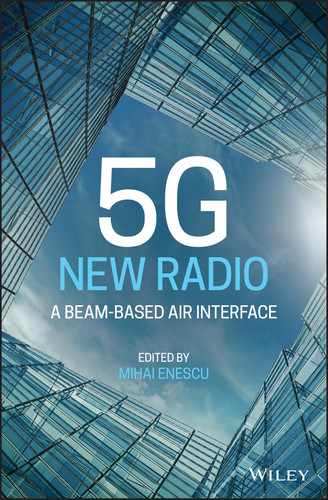A guide to the 3GPP-specified 5G physical layer with a focus on the new beam-based dimension in the radio system 5G New Radio: A Beam-based Air Interface is an authoritative guide to the newly 3GPP-specified 5G physical layer. The contributors—noted experts on the topic and creators of the actual standard—focus on the beam-based operation which is a new dimension in the radio system due to the millimeter wave deployments of 5G. The book contains information that complements the 3GPP specification and helps to connect the dots regarding key features. The book assumes a basic knowledge of multi-antenna technologies and covers the physical layer aspects related to beam operation, such as initial access, details of reference signal design, beam management, and DL and UL data channel transmission. The contributors also provide a brief overview of standardization efforts, IMT-2020 submission, 5G spectrum, and performance analysis of 5G components. This important text: Written for students and development engineers working with 5G NR, 5G New Radio: A Beam-based Air Interface offers an expert analysis of the 3GPP-specified 5G physical layer.
Table of Contents
- Cover
- List of Contributors
- Preface
- Acknowledgments
- Abbreviations
- 1 Introduction and Background
- 2 Network Architecture and NR Radio Protocols
- 3 PHY Layer
- 3.1 Introduction (Mihai Enescu, Nokia Bell Labs, Finland)
- 3.2 NR Waveforms (Youngsoo Yuk, Nokia Bell Labs, Korea)
- 3.3 Antenna Architectures in 5G (Fred Vook, Nokia Bell Labs, USA)
- 3.4 Frame Structure and Resource Allocation (Karri Ranta-aho, Nokia Bell Labs, Finland)
- 3.5 Synchronization Signals and Broadcast Channels in NR Beam-Based System (Jorma Kaikkonen, Sami Hakola, Nokia Bell Labs, Finland)
- 3.6 Physical Random Access Channel (PRACH) (Emad Farag, Nokia Bell Labs, USA)
- 3.7 CSI-RS (Stephen Grant, Ericsson, USA)
- 3.8 PDSCH and PUSCH DM-RS, Qualcomm Technologies, Inc. (Alexandros Manolakos, Qualcomm Technologies, Inc, USA)
- 3.9 Phrase- Tracking RS (Youngsoo Yuk, Nokia Bell Labs, Korea)
- 3.10 SRS (Stephen Grant, Ericsson, USA)
- 3.11 Power Control (Mihai Enescu, Nokia Bell Labs, Finland)
- 3.12 DL and UL Transmission Framework (Mihai Enescu, Nokia, Karri Ranta-aho, Nokia Bell Labs, Finland)
- Notes
- 4 Main Radio Interface Related System Procedures
- 4.1 Initial Access (Jorma Kaikkonen, Sami Hakola, Nokia Bell Labs, Finland, Emad Farag, Nokia Bell Labs, USA)
- 4.2 Beam Management (Mihai Enescu, Nokia Bell Labs, Finland, Claes Tidestav, Ericsson, Sweden, Sami Hakola, Juha Karjalainen, Nokia Bell Labs, Finland)
- 4.3 CSI Framework (Sebastian Faxér, Ericsson, Sweden)
- 4.4 Radio Link Monitoring (Claes Tidestav, Ericsson, Sweden, Dawid Koziol, Nokia Bell Labs, Poland)
- 4.5 Radio Resource Management (RRM) and Mobility (Helka-Liina Määttänen, Ericsson, Finland, Dawid Koziol, Nokia Bell Labs, Poland, Claes Tidestav, Ericsson, Sweden)
- Note
- 5 Performance Characteristics of 5G New Radio
- 6 UE Features
- References
- Index
- End User License Agreement
